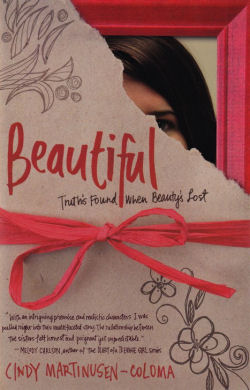
Bestselling author Cindy Martinusen Coloma has published nine novels, two nonfiction books and over a hundred articles. She's a speaker, book doctor and writing coach. Her novel Orchid House hit the ECPA bestsellers list, The Salt Garden was listed on Library Journal's Best Books 2004 and Winter Passing was a Christy Award finalist and RWA Reader's Choice finalist. She lives in Northern California with her husband, two teen and one nearly teen children, and their singing dog Allie (Allie will be featured in her upcoming novel Caleb+Kate). The entire family enjoys outside activities, books, movies, traveling, and they often have idea discussions for Cindy's books. Visit her at www.cindycoloma.com and www.cindycoloma-ya.com. |
|
Speaking Teen |
|
|
I walked into my local Barnes & Noble recently and was hit off-kilter, feeling like I’d just entered the Twilight Zone. They had moved the books around! After I recovered, I started exploring. When I wandered down one major traffic aisle, I found the new and greatly expanded YA section. The Harry Potter series might have helped renew the young adult market, but the vampires, werewolves, and angst-ridden teens are continuing to give the genre a blockbuster following. In the Christian market, publishers have broadened their teen lines with everything from thrillers and fantasy to romance and edgy dramas. According to the Huffington Post on January 4, 2010, young adult fiction is facing a bright future: “As the Boomers lose their eyesight and their children become teenagers, demographics will favor books for young adults over books for adults.” For YA writers or those thinking of testing these waters, this is good news in an overall wintry publishing climate. After writing six adult inspirational novels, I my editor asked me to try my hand at a YA novel. I jumped at the opportunity and recently finished my third book for the genre. I thoroughly enjoyed the journey and learned a few lessons along the way. TIME MACHINE The key to writing for young adults is to grow down, instead of up. In growing down, we must be careful not to go too far and end up in the magical childhood years. Instead, we must stop right in the middle of what is commonly the most tumultuous time in the human experience. These years are filled with big dreams, inconvenient acne, hormones gone wild, intense crushes (or are they love?), social and physical awkwardness, longings, hopes, confusion, belief, fear . . . Nearly every emotion and experience for the good and the bad gets stuffed into one giant Pandora’s Box that is opened on a regular basis. It’s a time when a few months in a relationship is long-term, a rumor can bring devastation, and a mean girl can alter the path of a life. For some teens, their lives are just emerging from their secure shells, while others have already been jaded by the pain and suffering of this world. It seems everything good and everything bad is compressed together like a bomb ready to blow at any wrong movement. As a writer, it’s important to truly understand all these aspects. Whether we loved or hated those years, to write for young adults, we definitely have to “go back there” and experience old feelings and see our peers with new eyes. It’s time to go back to high school. INWARD & OUTWARD “Is it harder to write for teens than to write for adults?” I’ve been asked this question a number of times. In my opinion, for the inside lives of the characters and for the story journey, the writing is very similar. The feelings, thoughts, and mistakes adult characters make are often reflections of the same feelings, thoughts, and mistakes of a teen. I wish we adults had really learned from the past, but the human experience often repeats itself from the teen years on up. What is different for teens is that it’s all amplified and sped up. For example, falling in and out of love can happen in a day with a teen, whereas to make that believable in an adult novel would take more work. The outward, or outer world, is another story. For one, technology is part of a teen’s life like electricity and running water is for us adults. A teen will text message multiple people, holding various conversations, while sitting in front of the TV, working on a computer, playing a video game, or chatting with the family. It’s the norm, not the exception. This was probably one of my biggest challenges when writing my YA novels. How do I weave in all these conversations into my characters’ lives? When does the reader get lost, or me—the author—get lost? A careful balance must be achieved between what should be shown, what can be summarized, and what progresses the story forward. Unless you’re writing historical YA or an Amish teen novel, technology must be part of the landscape. Other challenges in the outward sphere are language, slangs, fashion, styles, and groups (“emos” are fading and punks are out). In my first YA, Ruby Unscripted, lower-middle-class, conservative Ruby moves to the affluent and liberal Marin County. Her clothing, car, and beliefs are very different from most of the teens she first encounters. In my second YA, Beautiful, Ellie is one of those seemingly perfect Christian girls, while her sister, Megan, is labeled “trouble.” In upcoming Caleb+Kate, Kate is wealthy and attends a private school. For each of the books, the styles, voices, slangs, fashion, groups of friends, even bedroom |
décors are all very different from one another because of who the characters are. For YA fiction, we must make the outer and inner worlds of our characters believable or readers will shake their heads and toss the books aside. With two teen children and their friends around my house for the past six years, I’ve had writing fodder right under my roof. But if you need help, which most of us do, get around some teens and just listen. Also have a few teenagers read your manuscript and ask them what does and doesn’t ring true to them. RESPECT Teens see right through our attempts to preach, force a message, and act like a parent. We must respect our readers as equals during the writing process. These kids are smarter than we often realize. And, yes, in some areas they often think they are smarter than they truly are, but if we want to get them into our stories, we write to who they are. We must become the characters in the book just like an actor playing a role. While this is important in every kind of fiction, it’s even truer with teens. The world is larger than life. They’re already suspicious of adults, believing we don’t understand their world. We can’t prove them right in our writing. FEAR & TREMBLING When it comes down to it, I’m a parent and I care deeply for young adults. My teen years were full of angst and confusion. So it’s a weighty thing writing for this age, much more than writing for adults. The readers aren’t coming to my books to have another adult tell them what to do. They are coming to my books to enter a fiction world, to walk in the shoes of someone else, to feel and discover things they haven’t experienced in real life, and to find a connection or understanding that also helps them know that they aren’t alone. Stacked on top of that expectation is responsibility. Yes, I want to be authentic, but I also have a responsibility. Teens need wisdom. They need understanding. They need hope that comes through Christ. My books are sometimes subtle in the Christian message and other times overt, depending on the story, but I hope they all echo deep and true within my readers. Other writers have an overt message that is depicted through an authentic Christian character. Both are needed for Christian readers (and Christian readers are on a wide scale from ultra-conservative to liberal) and also for teens who haven’t discovered God and his grace. All of these books are necessary and in every genre—YA fiction includes every subgenre imaginable. Teens live in an age of vulnerability, confusion, vision, and decision—often a life is turned in one direction or another during these years. It’s momentous—a narrow passage that transforms a human from a child to an adult. As writers of this genre, we need to go deep and pray often, seeking guidance in what we should write about and how to deliver hope. The e-mails I’ve received from teen readers have inspired me. One girl stated, “I loved the book and felt like you really understood me.” Words like that make me hopeful that in a genre filled with every imaginable hopelessness, we can reach our youth with messages of eternal and grace-filled truths. |
|
|
|
|
|
|









